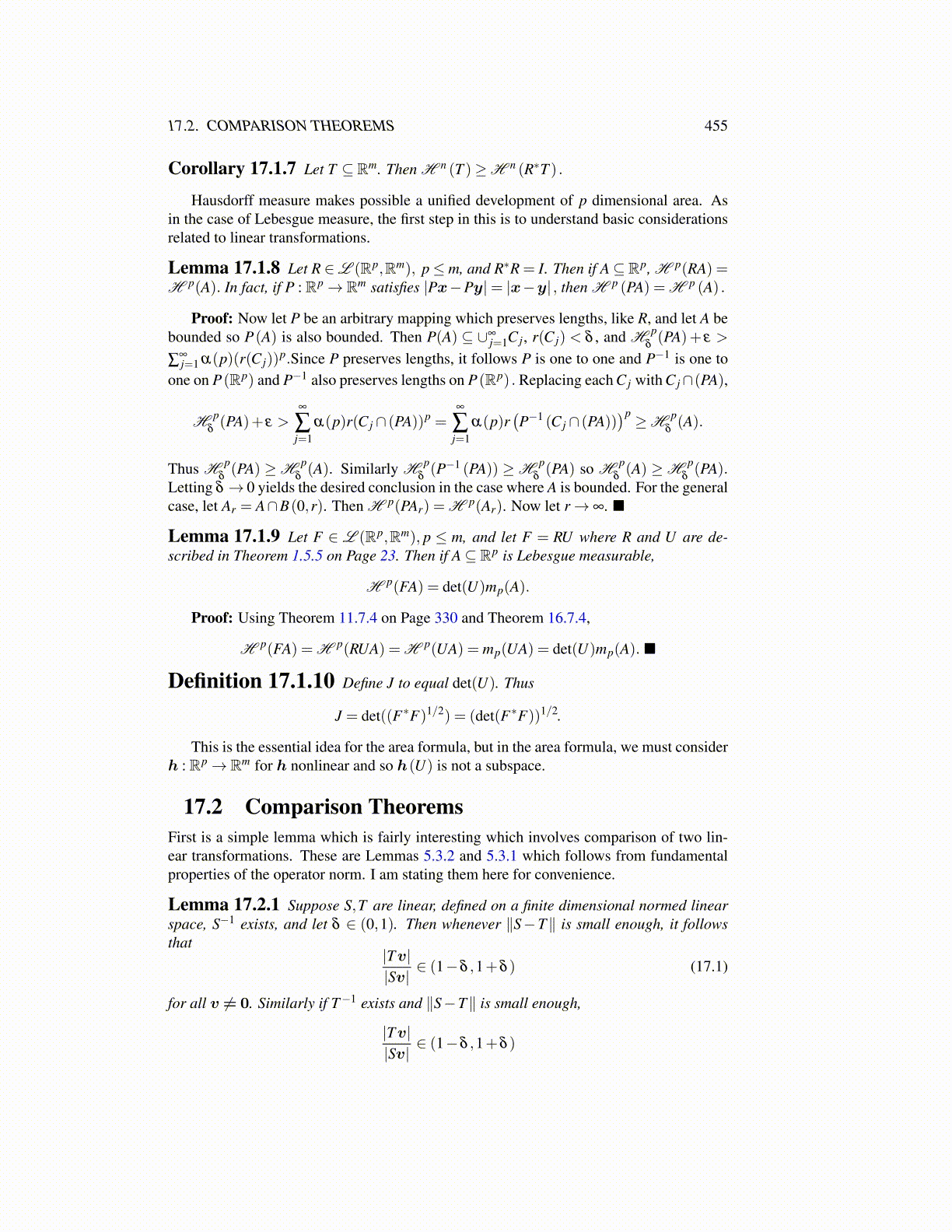
17.2. COMPARISON THEOREMS 455
Corollary 17.1.7 Let T ⊆ Rm. Then H n (T )≥H n (R∗T ) .
Hausdorff measure makes possible a unified development of p dimensional area. Asin the case of Lebesgue measure, the first step in this is to understand basic considerationsrelated to linear transformations.
Lemma 17.1.8 Let R ∈L (Rp,Rm), p≤m, and R∗R = I. Then if A⊆Rp, H p(RA) =H p(A). In fact, if P : Rp→ Rm satisfies |Px−Py|= |x−y| , then H p (PA) = H p (A) .
Proof: Now let P be an arbitrary mapping which preserves lengths, like R, and let A bebounded so P(A) is also bounded. Then P(A) ⊆ ∪∞
j=1C j, r(C j) < δ , and H pδ(PA)+ ε >
∑∞j=1 α(p)(r(C j))
p.Since P preserves lengths, it follows P is one to one and P−1 is one toone on P(Rp) and P−1 also preserves lengths on P(Rp) . Replacing each C j with C j∩(PA),
H pδ(PA)+ ε >
∞
∑j=1
α(p)r(C j ∩ (PA))p =∞
∑j=1
α(p)r(P−1 (C j ∩ (PA))
)p ≥H pδ(A).
Thus H pδ(PA) ≥H p
δ(A). Similarly H p
δ(P−1 (PA)) ≥H p
δ(PA) so H p
δ(A) ≥H p
δ(PA).
Letting δ → 0 yields the desired conclusion in the case where A is bounded. For the generalcase, let Ar = A∩B(0,r). Then H p(PAr) = H p(Ar). Now let r→ ∞. ■
Lemma 17.1.9 Let F ∈ L (Rp,Rm), p ≤ m, and let F = RU where R and U are de-scribed in Theorem 1.5.5 on Page 23. Then if A⊆ Rp is Lebesgue measurable,
H p(FA) = det(U)mp(A).
Proof: Using Theorem 11.7.4 on Page 330 and Theorem 16.7.4,
H p(FA) = H p(RUA) = H p(UA) = mp(UA) = det(U)mp(A). ■
Definition 17.1.10 Define J to equal det(U). Thus
J = det((F∗F)1/2) = (det(F∗F))1/2.
This is the essential idea for the area formula, but in the area formula, we must considerh : Rp→ Rm for h nonlinear and so h(U) is not a subspace.
17.2 Comparison TheoremsFirst is a simple lemma which is fairly interesting which involves comparison of two lin-ear transformations. These are Lemmas 5.3.2 and 5.3.1 which follows from fundamentalproperties of the operator norm. I am stating them here for convenience.
Lemma 17.2.1 Suppose S,T are linear, defined on a finite dimensional normed linearspace, S−1 exists, and let δ ∈ (0,1). Then whenever ∥S−T∥ is small enough, it followsthat
|Tv||Sv|
∈ (1−δ ,1+δ ) (17.1)
for all v ̸= 0. Similarly if T−1 exists and ∥S−T∥ is small enough,
|Tv||Sv|
∈ (1−δ ,1+δ )